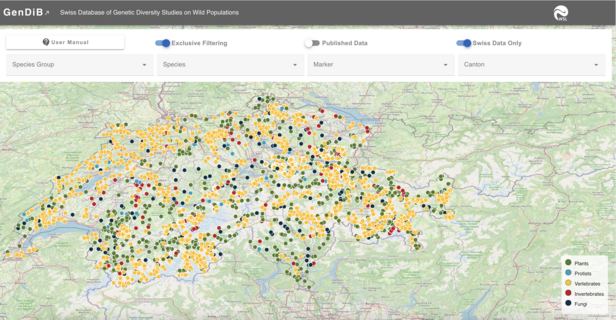A new national database on geo-referenced genetic diversity in populations of wild species
Ionut Iosifescu Enescu
Corine Buser
Evangelia Kolovou, Benjamin Dauphin, Andrin Gross, Rolf Holderegger, Deborah Marie Leigh, Rolf Meile, Christian Rellstab, Silvia Stofer
2022 - 2026
FinancingGenDiB ¶
Background: Genetic diversity is an integral part of biodiversity, recognized as key for population persistence in and adaptation to changing environments and extreme events. The global Convention on Biological Diversity (CBD) requires countries to assess and monitor, and eventually halt the loss of genetic diversity. However, there is no systematic collection of Swiss data tailored to the specific needs of Swiss stakeholders to support this process.
Aim: The GenDiB project carried out a needs and feasibility analysis on a new national database with geo-referenced data on intraspecific genetic diversity in populations of wild species in Switzerland, and is now developing a database prototype.
The concept developed as part of the project will provide the basis for a national database for hosting geo-referenced datasets of within-population genetic data. Such a database can provide a baseline for evaluating spatial patterns of intraspecific genetic diversity across a broad range of taxa, detect populations and areas of conservation concern, and allow for the assessment of temporal changes or effects of extremes. Such information will help improve and develop conservation measures. Additionally, these data can be accessed for teaching purposes.
Current developments: We conducted a literature search to record the existing data sets on genetic diversity in natural populations in Switzerland. In addition, we are conducting a survey of researchers in an attempt to make previously unpublished datasets accessible (e.g. BSc, MSc, PhD theses). These datasets will be added to on an ongoing basis. If you are in possession of further data sets, you are welcome to contact us directly and share this information with interested colleagues.
The attributes or metadata corresponding to the genetic datasets needed for our work are compiled in a table, which can be downloaded here. The completed table can be returned to us by email.
After compilation, the collected genetic data will be grouped according to species and displayed in an interactive map. This map is freely available via our project page and will contain links to the data and articles.
If you have any questions or suggestions, please contact us.
References:
Buser C, Mosimann M, Iosifescu-Enescu I, Woodcock S, Gugerli F 2023. Nutzen einer nationalen Datenbank zur innerartlichen genetischen Vielfalt für die Naturschutzpraxis. N & L inside 2/23: 33–40.
Leigh DM, Vandergast AG, Hunter ME, Crandall ED, Funk WC, Garroway CJ, Hoban S, Oyler-McCance SJ, Rellstab C, Segelbacher G, Schmidt C, Vázquez-Domínguez E, Paz-Vinas I. Best practices for genetic and genomic data archiving. Nat Ecol Evol (2024). doi.org/10.1038/s41559-024-02423-7
